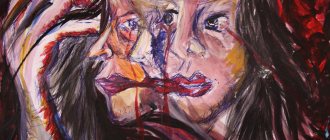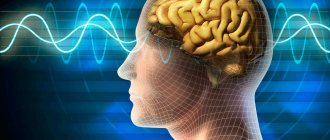Forms of schizophrenia and course
Treatment of schizophrenia - we use soft hospital replacement techniques without the use of psychotropic drugs.
Schizophrenia is a group of diseases characterized by disharmony and loss of unity of mental functions (thinking, emotions, motor skills), a combination of productive (delusions, hallucinations, etc.) and negative (decreased volitional activity, emotional impoverishment, increased introversion, etc.) symptoms, long-term and progressive course, united by a common development mechanism and the same outcome of the disease (development of the so-called schizophrenic defect).
The term schizophrenia has been used since 1911, after E. Bleuler combined the previously observed dementia praecox, hebephrenia, catatonia and chronic delusional psychoses into one disease. Schizophrenia is diagnosed in approximately 1% of the population, with approximately equal prevalence in men and women. This disease affects approximately 45 million people in the world, and it is diagnosed in 4.5 million people every year. In Russia, the incidence and prevalence of schizophrenia are at the world average.
Forms of schizophrenia
- in the form of psychoses with severe mental disorders in the form of delusions, hallucinations, aggressive behavior, freezing;
- in the form of non-rough, so-called borderline disorders (the appearance of obsessive thoughts, mood changes, the appearance of unpleasant sensations in various parts of the body, etc.),
- and also under the guise of subtle personality changes (loss of previous interests, increasing isolation, passion for “occult” knowledge, etc.).
Variants of the course of schizophrenia
- unfavorable forms of schizophrenia, in which the disease, after its onset, proceeds only with progression and leads to the disintegration of personality in a short time (several years)
- a continuous course in which the symptoms of the disease do not stop, there are no temporary lulls.
- paroxysmal course, in which attacks of the disease can be replaced by more or less long periods without painful disorders (remission). Moreover, there are people who have suffered only one attack in their entire lives.
- paroxysmal-progressive course, there is a kind of intermediate type of course, in which increasing personality changes are observed between attacks.
Statistics, risk group
Schizophrenia is an endogenous pathology that ranks first among psychoses in terms of prevalence, progression and severity of consequences in the social sphere of the individual.
In recent years, there has been an increase in the number of young patients. The paranoid form of the disease is the most common variant. Over the course of 1 year, 560,000–600,000 patients suffering from schizophrenia are registered in Russia. Of the indicated number, 85-87% of patients have a paranoid form. People with a genetic predisposition to psychosis are at risk. The paranoid form most often occurs in people aged 25 to 35 years. Delusional and hallucinatory disorders predominate.
Men are affected more often than women. Statistics indicate the following. 100% of patients experience severe behavioral disturbances. Negative symptoms were present in 96% of those studied, delirium in 93%. Chronic paranoid symptoms are diagnosed less frequently - in 67% of patients. Verbal hallucinations are characteristic of 59% of patients. Men are more likely to have persistent delusions (men - in 98% of cases, women - in 87%). Catatonic behavior is characteristic of men (in 13% of cases, and in women - in 2% of cases).
Main forms of schizophrenia
Diagnosis of forms of schizophrenia, even in cases of severe painful disorders in the form of psychoses with seemingly obvious schizophrenic symptoms, requires caution. Not all psychoses with delusions, hallucinations and catatonic symptoms (freezing, agitation) are manifestations of schizophrenia. Below are the most specific psychotic symptoms for schizophrenia (the so-called first-rank symptoms).
Openness of thoughts – the feeling that thoughts can be heard from a distance. Feeling of alienation is the feeling that thoughts, feelings, intentions and actions come from external sources and do not belong to the patient.
Feeling influenced - the feeling that thoughts, feelings and actions are imposed by some external forces that must be passively obeyed.
Delusional perception is the organization of real perceptions into a special system, often leading to false ideas and conflict with reality.
Auditory hallucinations are clearly audible voices emanating from inside the head (pseudohallucinations), commenting on the actions or pronouncing the patient’s thoughts.
Differential diagnosis
In cases of acute illness, a doctor can assume schizophrenia based on an examination, conversation with the patient, information from loved ones about how behavioral disorders developed, how the patient behaved. Accurate diagnosis of the form of schizophrenia, especially in cases where the disease is not severe, sometimes requires hospitalization. Modern scientists consider it necessary to monitor the patient for at least a month in order for the diagnosis to be accurate. In these cases, in addition to assessing the history of the disease and the patient’s condition upon admission, the doctor observes the patient’s behavior in the hospital (or day hospital), and also carries out various diagnostic manipulations to exclude other causes of mental disorders.
One of the diagnostically valuable types of examinations is a pathopsychological examination, during which higher mental functions are assessed:
- memory
- attention
- thinking
- intelligence
- emotional sphere
- volitional characteristics
- personal characteristics, etc.
Depending on the manifestations of the disease and its course, several forms of schizophrenia are distinguished:
Paranoid form of schizophrenia
The most common form of the disease. It manifests itself as a relatively stable, usually systematized delusion (persistent false conclusions that cannot be dissuaded), often accompanied by hallucinations, especially auditory ones, as well as other perceptual disturbances. The most common symptoms of paranoid schizophrenia include:
- delusions of persecution, relationship and significance, high origin, special purpose, bodily changes, or jealousy;
- hallucinatory voices of a threatening or commanding nature or auditory hallucinations without verbal expression, such as whistling, humming, laughter, etc.;
- olfactory or taste hallucinations, sexual or other bodily sensations.
Visual hallucinations may also occur. In the acute stages of paranoid schizophrenia, the behavior of patients is grossly disturbed and is determined by the content of painful experiences. So, for example, with delusions of persecution, the sick person either tries to hide, escape from imaginary pursuers, or attack and try to defend himself. With auditory hallucinations of a commanding nature, patients can carry out these “commands”, for example, throw things out of the house, swear, grimace, etc.
Hebephrenic form of schizophrenia
More often, the disease begins in adolescence or young adulthood with a change in character, the appearance of a superficial and mannered passion for philosophy, religion, the occult and other abstract theories. Behavior becomes unpredictable and irresponsible, patients look infantile and foolish (they make ridiculous faces, grimace, giggle), and often strive for isolation. The most common symptoms of hebephrenic schizophrenia include:
- distinct emotional flatness or inadequacy;
- behavior characterized by goofiness, mannerisms, grimaces (often with giggles, smugness, self-absorbed smiles, grand manners);
- distinct thinking disorders in the form of broken speech (violation of logical connections, jumping thoughts, connection of heterogeneous elements not related in meaning);
- hallucinations and delusions may not be present.
To diagnose the hebephrenic form of schizophrenia, it is necessary to monitor the patient for 2-3 months, during which the above-described behavior persists.
Catatonic form of schizophrenia
In this form of the disease, movement disorders predominate, which can vary in extremes from freezing to hyperactivity, or from automatic submission to senseless resistance, the patient’s unmotivated refusal to perform any movement, action or resistance to its implementation with the help of another person. Episodes of aggressive behavior may occur.
In the catatonic form of schizophrenia, the following symptoms are observed:
- stupor (a state of mental and motor retardation, reactions to the environment, spontaneous movements and activity decrease) or mutism (lack of verbal communication between the patient and others while the speech apparatus is intact);
- excitement (purposeless motor activity, not subject to external stimuli);
- freezing (voluntary acceptance and retention of an inadequate or pretentious pose);
- negativism (meaningless resistance or movement in the opposite direction in response to all instructions or attempts to change position or move);
- rigidity (holding a pose in response to an attempt to change it);
- “waxy flexibility” (holding body parts in a given position, even uncomfortable and requiring significant muscle tension);
- automatic obedience;
- getting stuck in the mind of one thought or idea with their monotonous repetition in response to newly asked questions that no longer have anything to do with the original ones.
The above symptoms can be combined with a dream-like state, with vivid scene-like hallucinations (oneiroid). Isolated catatonic symptoms can occur in any other form and other mental disorders. For example, after suffering traumatic brain injuries, in case of poisoning with psychoactive substances, etc.
Characteristic
Progressive schizophrenia (coat-like) involves attacks alternating with remission.
During the period of remission, a spasmodic transformation of the personality is noticeable. The first cases of the disease were falsely mistaken for a continuous, sluggish course of a recurrent type of schizophrenia. But through research, a difference was revealed. It has been established that the progressive variant of the pathology often provokes the rapid formation of defects. Transformations increase with each subsequent attack. But not every exacerbation qualifies as a “coat” of schizophrenia, and not after every exacerbation personal pathologies are formed.
The disease in most cases begins after adolescence, most often in people over 25 years of age. However, a separate, juvenile type of progressive schizophrenia has been identified. The fur-like form in adults does not develop quickly, and the manifestation is not acute. At the initial stage, the following symptoms appear:
- obsessive thoughts and actions;
- hypochondria;
- false recognitions;
- symptoms of catatonic syndrome;
- delusional ideas, which are characterized by systematization;
- psychopathic-type disorders - egocentricity, antisocial behavior, etc.
Already at the beginning of the formation of the disease, personal transformations are noticeable. The person becomes more withdrawn, gloomy, and anxious. Delusional ideas relate to the theme of jealousy, relationships, persecution. Paranoid traits, delusions about physical impact, mental automatisms like Kandinsky-Clerambault syndrome appear after 3-7 years of illness.
Hallucinations are a common symptom of many types of schizophrenia. With a fur-like appearance, hallucinatory-paranoid syndrome often forms at the onset of the disease. Then it either continues to progress (with a hallucinatory version of the course), or is replaced by acute delirium (delusional version of the course).
There is a classification of attacks in the fur-like form of schizophrenia: exacerbations with dominance of affective disorders, psychopathic-like, neurosis-like, depressive, hallucinatory, catatonic, etc. The course of the disease also varies among patients. A protracted course is possible, followed by a repeated episode of remission.
Simple forms of schizophrenia
With this form of schizophrenia, oddities and inappropriate behavior gradually develop, and overall productivity and performance decrease. Delusions and hallucinations are usually not observed. Vagrancy, absolute inactivity, and aimlessness of existence appear. This form is rare. To diagnose a simple form of schizophrenia, the following criteria are needed:
- the presence of progressive development of the disease;
- the presence of characteristic negative symptoms of schizophrenia (apathy, lack of motivation, loss of desires, complete indifference and inactivity, cessation of communication due to loss of responsiveness, emotional and social isolation) without pronounced delusional, hallucinatory and catatonic manifestations;
- significant changes in behavior, manifested by a pronounced loss of interests, inactivity and autism (immersion in the world of subjective experiences with weakening or loss of contact with the surrounding reality).
Residual (residual) schizophrenia
In this form, after psychotic attacks of the disease, only negative schizophrenic symptoms persist and continue for a long time: decreased volitional and emotional activity, autism. The patients’ speech is poor and inexpressive, self-care skills, social and labor productivity are lost, interest in married life and communication with loved ones fades, and indifference to relatives and children appears. Such conditions in psychiatry are usually defined as a schizophrenic defect (or the final state of schizophrenia). Due to the fact that with this form of the disease the ability to work is almost always reduced or lost, and patients often need outside supervision, special commissions determine the disability group for patients.
In the residual form of schizophrenia, the following symptoms are observed:
- distinct negative schizophrenic symptoms, that is, psychomotor slowing, decreased activity, emotional flatness, passivity and lack of initiative; poverty of speech, both in content and quantity; poor facial expressions, eye contact, voice modulation and posture; lack of self-care skills and social productivity;
- the presence in the past of at least one distinct psychotic episode that meets the criteria for schizophrenia;
- the presence of a period, albeit once a year, during which the intensity and frequency of significant symptoms such as delusions and hallucinations would be minimal in the presence of negative schizophrenic symptoms;
- absence of dementia or other brain diseases;
- absence of chronic depression and hospitalization, which could explain the presence of negative disorders.
Social readaptation tasks of adolescent psychiatry underlie the unrelenting interest in the study of schizophrenic psychoses, the clinical picture of remissions and the typology of the defect in people of this age group (2, 3, 8, 10, I, 12, 16, 19).
The main objective of this study was a comparative clinical and follow-up study of the nature of the formation of remissions in adolescents with recurrent and paroxysmal-progressive schizophrenia, as well as to identify the relationship between the clinical and dynamic structure of remissions and the psychopathological picture of attacks, the pre-manifest period and premorbid.
In accordance with the task, 12 patients (both female and 1 male) with recurrent schizophrenia in adolescents who suffered 22 affective-oneiric attacks and 33 patients (21 females and 12 males) with paroxysmal-progressive schizophrenia in adolescents who suffered 54 catatonic attacks were examined clinically and follow-up. -oneiric attack of the disease.
The age of patients during the manifestation of the disease was from 12 to 17 years. The duration of follow-up is 4-8 years. During the last follow-up examination, the patients were aged 17–23 years.
Affective-oneiric attacks of recurrent schizophrenia occurred acutely, spontaneously, in almost 2/3 of observations with somatized symptoms, in 1/3 with an intensification of the affective disorders preceding the attack. Then a state of anxiety and acute sensory delirium developed, the changing plot of which reflected the leading affect. Sometimes elementary hallucinatory disorders were noted. At the next stage of the attack, affective-delusional derealization and depersonalization with false recognitions and illusions of a negative and positive double were established. Next, an ordinary, primitive delirium of meaning and dramatization was formed, which soon took on a fantastic character. This was followed by oneiric stupefaction with fantastic ideas, complete detachment from the outside world, and stuporous symptoms. The state of inhibition was at times interrupted by impulsive actions and was short-lived. In 1/3 of the observations, there was a further worsening of the condition with an increase in catatonic excitement with confusion and subsequent amnesia. The recovery from affective-oneiric attacks is critical with full awareness of the disease. The duration of attacks is from 1.5 to 3.5 weeks.
Catatonic-oneiric attacks of paroxysmal-progressive schizophrenia, despite the similarity in their development, differed in the following features. They arose equally acutely and subacutely, spontaneously and provoked by the appearance or intensification of atypical subdepressive disorders (lethargy, mental and physical fatigue with irritable weakness, loss of interest in studies). At the next stage of the disease, a changeable sensory delirium was formed with influxes of figurative ideas, phenomena of openness, and elementary hallucinatory deceptions. Then delusional derealization and depersonalization, delusion of meaning and, in rare cases, short-term, rudimentary phenomena of delusion of staging were established. Oneiric manifestations were erased, short-lived and usually oriented in nature. A prolonged (from 2 to 12 weeks) extensive catatonic stage with a predominance of stuporous disorders turned out to be preferable for this type of attack. Against the background of catatonic disorders, most patients periodically experienced elements of delusions of meaning, false recognitions, and influxes of figurative ideas. In a third of observations, the catatonic stage proceeded as lucid catatonia. The attacks ended in a catatonic-hebephrenic state, when, along with subcatatonic symptoms, traits of foolishness appeared in the patients’ behavior. At the same time, there was a temporary regression of behavioral skills and, in some patients, neatness skills. The recovery from catatonic-oneiric attacks was lytic, lasting 2-4 weeks, during which affective disorders such as affective lability reappeared. In hypomania, lower drives and instincts (gluttony, sexuality) were disinhibited. Primitive, stereotypical obsessions arose (patients bit their nails, scratched the skin of their hands and faces, scratched themselves, opened their eyes wide, moved their shoulders, etc.). Subdepression was characterized by lethargy, drowsiness, physical fatigue, and indifference to the environment. No criticism of the psychotic state suffered was developed. The duration of catatonic-oneiric attacks is from 8 to 24 weeks.
Having completed the description of the types of attacks, we will accordingly consider the formation of remissions in patients of both groups. In patients who suffered affective-oneiric attacks of recurrent schizophrenia, remission formed gradually. At the first stages of its development, continuous affective disorders were discovered. Hypomania prevailed over time. They were characterized by a cheerful mood, cheerfulness, and an increase in ideational and motor activity. The patients became extremely energetic, took on many things at once, made “grand” plans for the near future, strived to be in the company of their peers, and fell in love. They were highly productive in their classes, completed assignments quickly, learned the material from the teacher’s words, received high grades, and were confident in their knowledge. Already at this stage, they were critical of the psychosis they had suffered and willingly told the doctor about it. These states were interrupted by short-term, from several days to 1-2 weeks, subdepressions. The peculiarities of the latter include the absence of vitality phenomena and ideas of guilt. Asthenic disorders with lethargy, drowsiness, increased fatigue, tearfulness, and hyperesthesia predominated in depression. In some patients, after somato- and psychogenia, during menstruation, subdepression with senestoalgia, verbal illusions, sensitive ideas of attitude, fears for the health of oneself and loved ones arose. In isolated cases, ideas of meaning were discovered. These conditions were managed without additional treatment, after restoration of somatic well-being, after the psychogenic situation had passed.
After an average of 8-12 months from the onset of remission, affective disorders lost their continuous nature. An even mood began to prevail. Affective disorders arose predominantly seasonally in the spring and autumn periods in the form of unipolar or bipolar states. And even later, similar conditions arose only in connection with somatic and mental provocations. Further, the severity of affective disorders was smoothed out, the duration of their manifestations was shortened. And finally, affective disorders disappeared completely. At this stage, the somatic changes that arose in patients towards the end of full-blown manifest attacks of psychosis subsided, excessive fullness subsided, and the facial features returned to their former liveliness and subtlety. The so-called “ripening of remission” began (4, 8).
By this time, subtle personality changes were becoming noticeable. The patients partially lost the sthenicity and assertiveness characteristic of them in premorbidity, and more easily retreated from their views and previous positions in life. With sufficiently preserved sociability, the circle of acquaintances and friends narrowed, and rationality appeared in the approach to them. There was a slight emotional leveling; teenagers were calmer about both failures and success. Most patients remained attached to loved ones, listened to their opinions and advice, but became drier in their feelings. In addition, some felt their inadequacy and became more dependent on their relatives. Some of them became sensitive. Understanding of other people's failures was more accessible to them; they began to empathize with others in adversity and trouble. Fearing the possibility of the disease returning, they developed a gentle regimen, avoided bad habits, and monitored their health. Activity, while remaining high, still did not reach the previous premorbid level. The teenagers continued to study well, but now they spent more time preparing their lessons. Unable to prepare all their homework as before, they began to selectively prepare lessons and postponed their completion to subsequent days of the week. My work and interests became more scattered, I got tired faster, and needed additional rest.
Unlike the patients of the previous group, almost all adolescents with paroxysmal-progressive schizophrenia with catatonic-oneiric attacks had asthenoadynamic disorders clearly detected in the first stages of remission. Most patients got out of bed only to eat, went to bed early, woke up late, and remained drowsy throughout the day. The teenagers were not interested in anything, did not read, did not watch TV shows. It was almost impossible to get them to study; they could not concentrate on what they were reading. They treated their surroundings and their condition with indifference. Minimal loads caused them severe mental and physical exhaustion. At this stage of remission, patients retained increased appetite and experienced significant weight gain (up to 10-15 kg).
On average, 6-8 months after the onset of remission, patients began to resume activity in the evening hours. Then they took on homework, watched TV shows, and paid attention to the reactions of loved ones. After another 5-10 months, drowsiness in the morning gradually disappeared, then the need for daytime sleep disappeared, interest in the environment appeared, the first signs of restoration of attention and performance. The patients began to help their relatives with housework and tried to study. By this period, for most of them, the obesity that had emerged during the attack and in the first stages of remission disappeared, and the previously gained weight decreased to normal.
Only 18-24 months after the end of the attack of the disease did the “final maturation of remission” occur (19). Despite the fact that by this time the asthenic manifestations of the disease were significantly reduced, the activity of the patients did not reach the premorbid level, passivity, the need for constant stimulation from the outside, and low academic performance remained. Teenagers showed dry feelings and became more dependent on loved ones than attached to them. Closed in premorbidity, after an attack of psychosis they became even more alienated, were not burdened by the loss of friends, preferred to maintain relationships with sick friends, and spent their leisure time with their families.
Due to the presence of continuous affective disorders with a predominance of hypomanic phases, all patients who suffered affective-oneiric attacks of recurrent schizophrenia were treated with lithium carbonate in doses of 300 to 1200 mg/day. At the same time, the level of lithium salts in the blood was monitored (0.4-0.8 mEq/liter). Treatment with lithium carbonate during the period of remission was combined with small doses of antipsychotics (stelazine, triftazine 10-15 mg/day; neuleptil 10-20 mg/day; melleril 30-60 mg/day; eglonil 50-150 mg/day), tranquilizers ( seduxen, relanium, valium 10-15 mg/day; tazepam 10-30 mg/day), antidepressants (pirazidol, amitriptyline 25-50 mg/day). Over the next 2-4 years, patients received preventive treatment with small doses of lithium carbonate (up to 600 mg/day) maintaining a blood level of at least 0.33 mEq/liter. During the period of remission, patients also needed to be provided with an additional free day in the school week, protected from trips to construction teams, labor camps, and out-of-town excursions.
Patients who suffered catatonic-oneiric attacks of paroxysmal-progressive schizophrenia did not require treatment with lithium carbonate. Due to low activity, combined with primitive drives and stereotyped obsessions, at the end of the attack and during the period of remission, they continued to receive small doses of antipsychotics (Neuleptil 10-30 mg/day; Melleril 20-60 mg/day) in combination with nootropics (piracetam, nootropil 400-1200 mg/day). Along with drug therapy, psychocorrective measures were carried out (the level of requirements was reduced, individual training).
When comparing the course of the disease as a whole in patients from the groups described above, it should be noted the differences in the pre-manifest and premorbid periods of the disease.
The majority of adolescent patients with recurrent schizophrenia developed near-circular affective disorders 0.5–3 years before the manifest affective-oneiric attack. Subdepression occurred with ideational and motor retardation, daily mood swings, and somatovegetative disorders; hypomania - with a joyful attitude, high activity, productivity in classes, sociability. And in patients with paroxysmal-progressive schizophrenia, atypical affective disorders were noted 0.5-3 years before the manifest catatonic-oneiric attack. Subdepression occurred with lethargy, passivity, indifference to the environment, loss of interest in activities, or with irritable weakness and fussiness. Patients got tired easily, had difficulty learning new material, and complained of headaches, muscle weakness, and dizziness. Despite a long night's sleep, they woke up late, felt tired in the morning, and refused to eat. During the day the condition fluctuated, in the evening hours lethargy, passivity, fatigue decreased, appetite and performance increased. Hypomania proceeded as “flat”, without gaiety, cheerfulness with agitation, anger, sexual desires, loss of interest in studies, and former hobbies.
In the premorbid period, patients with recurrent schizophrenia who had suffered affective-oneiric attacks could be defined as hyperthymic sthenic schizoids with high intellectual abilities. Some female patients experienced irritability during menstruation. In the premorbid period, patients with paroxysmal-progressive schizophrenia who suffered catatonic-oneiric attacks could be defined as passive and sensitive schizoids with average intellectual abilities. Moreover, all female patients during menstruation experienced lethargy, irritability, sleep disturbances, and appetite (“asthenic inclusions”, according to M. V. Korkina, 5).
Clinical follow-up observation revealed repeated (second, third) attacks of the disease in 5 out of 12 patients with recurrent schizophrenia, 18-24 months after the completion of manifest affective-oneiric attacks. They were observed for the most part after somatic and mental provocations (infections, injuries, work in labor camps, construction teams, changes in place of residence, school, etc.). Repeated attacks were mainly short-term affective-oneiric, in half of the observations - transient, reduced affective-delusional. After the repeated attack of psychosis had passed, during remission, continuous affective disorders with a predominance (over time) of hypomania were observed. However, hypomania occurred with aproductivity, elements of foolishness in behavior, anger, subdepression - with a pronounced asthenic component: increased fatigue, drowsiness, easily occurring irritability, tearfulness. Against this background, short-term anxiety, obsessive fears of the possibility of a return of the painful state, and fragmentary ideas of relationship arose periodically. Affective disorders after repeated attacks of the disease were reduced in a shorter period of time (7-8 months). Although in most patients, after repeated attacks of recurrent schizophrenia, it was not possible to detect a further deepening of the defect, some adolescents nevertheless became more practical, others became infantile with a symbiotic dependence on the mother.
12 of 33 adolescents with paroxysmal-progressive schizophrenia also had repeated attacks. The psychopathological picture in them worsened towards the predominance of catatonic disorders, the oneiric radical was lost in attacks. After repeated attacks of the disease, the dynamics of remission formation, similar to those previously described, were revealed. In the structure of the personality defect, a reduction in energy potential was more clearly revealed and emotional impoverishment increased.
A follow-up examination of patients with recurrent schizophrenia (12 people), aged 18-23 years, showed that 6 of them studied at higher educational institutions, 4 at technical schools, 2 completed their studies at a general school.
A follow-up examination of 33 patients with paroxysmal-progressive schizophrenia who had suffered catatonic-oneiric attacks, aged 18-23 years, showed that 2 of them studied at higher educational institutions, 4 - at technical schools, 5 - graduated from high school, 11 - after graduation and vocational schools worked in production, 8 - in occupational therapy workshops, 3 - had group II disability.
So, a comparative clinical follow-up study of a group of adolescents (45 people) with recurrent and paroxysmal-progressive schizophrenia showed that after affective-oneiric, as well as after catatonic-oneiric attacks, remissions were formed gradually over a long time. Previously, a number of authors (6, 20) wrote about the so-called “inactive” schizophrenia during the lytic exit from the acute period of a paroxysmal ongoing process, which lasts for months, often years, and defined it as a transition period of the upcoming stabilization of the process, the establishment of remission, formation and compensation defect.
In our material, the period of formation of remission after affective-oneiric attacks was delayed by 1-1.5 years. Stage I, lasting 8-12 months, was characterized by phasic continuous affective disorders. Hypomanic phases close to circular prevailed in time. Short-term subdepressions occurred predominantly with asthenic disorders. At stage II, lasting from 4 to 6 months, affective bipolar and unipolar disorders arose only seasonally, and even later were observed only in connection with somatic and mental provocations. The so-called “ripening of remission” began. At the same time, manifestations of a mental defect began to be detected in the form of a slight loss of the previous sthenicity, a narrowing of the range of interests, contacts, an increase in sensitivity, emotional leveling and a slight decrease in activity.
The period of remission after catatonic-oneiric attacks was delayed even more - by 1.5-2 years. Stage I, lasting 6-8 months, proceeded with a total drop in energy and manifestations of mental asthenia with drowsiness, exhaustion without symptoms of irritable weakness and affective lability. Some authors consider the described condition entirely within the range of asthenic disorders of a “pure defect” and consider it almost irreversible (18). Others associate these symptoms not so much with loss, but with inhibition, suppression, and dissociation of functions and suggest the possibility of their partial reversibility (7). Still others define such states as “temporary protection”, “therapeutic behavior”, “state of exhaustion and overwork after psychosis” and consider them to be completely reversible (16, 19). Our studies of the dynamics of remission in adolescent patients with paroxysmal-progressive schizophrenia showed partial reversibility of the detected disorders. Already at the second stage of remission, the activity and performance of patients began to recover. At stage III, the manifestations of mental asthenia were almost completely reduced. Then such symptoms of a mental defect as a decrease in activity, emotional dimming and, to a lesser extent, autism began to emerge.
Let us try to make some assumptions regarding the factors that determine the different dynamics of the formation of remissions after affective-oneiric and catatonic-oneiric attacks of schizophrenia in adolescents.
One of the main factors influencing the different dynamics of the formation of remissions is the type of disease and the structure of attacks. Affective disorders during an attack can be considered as a favorable prognostic sign, indicating a regressive course of the disease at a distant stage, catatonic - as an unfavorable one, indicating a tendency towards a progressive course of the disease. Oneiric disorders, which create the similarity of affective-oneiric and catatonic-oneiric attacks, rather indicate the severity of the development of the disease and do not carry prognostically significant criteria.
As it turned out, the structure of remission is in a fairly close connection with the nature of episodic psychopathological disorders in the pre-manifest period of the disease. Thus, if affective-oneiric attacks of recurrent schizophrenia in the pre-manifest period are preceded by affective disorders close to circular, then catatonic-oneiric attacks of paroxysmal-progressive schizophrenia are preceded by atypical affective disorders, moreover, with an obvious asthenic component and somato-vegetative disorders. Already at the pre-manifest stage, an endogenous radical was detected in depressive-asthenic episodes, which consisted of daily fluctuations in the state with a decrease in asthenia in the evening hours, or increased fatigue with indifference to the environment and lethargy of motives. The listed features of pre-manifest asthenic disorders resembled “youthful asthenic failure” (17) or “youthful mental failure” (13). These disorders in the pre-manifest period of paroxysmal-progressive schizophrenia, apparently, indicate a “deficient soil” (6), which, perhaps, determines the development of severe catatonic-oneiric attacks with a pronounced catatonic stage, a protracted development of remission and a drop in activity.
Our studies confirmed a certain relationship between the type of premorbid and the type of remission in patients. If affective-oneiric attacks and subsequent remissions with a predominance of circular affective disorders were observed mainly in hyperthymic sthenic schizoids with high intellectual abilities, then catatonic-oneiric attacks and subsequent remissions with a predominance of asthenoadynamic disorders developed mainly in passive and sensitive schizoids with average intellectual abilities . The dependence of the form of remission on the premorbid personality of patients is consistent with observations based on epidemiological material (15).
In the group of adolescents with paroxysmal-progressive schizophrenia, a significant increase in severity of the 2nd and 3rd attacks was noted with an increase in catatonic symptoms and loss of the oneiric radical, while in the group of patients with recurrent schizophrenia, there was mainly preservation of the affective-oneiric character along with a tendency for repeated attacks to be transient . This once again confirms the previously made assumption of a number of authors (14) about the increase in the proportion of severe attacks as the personality defect deepens.
The presence of asthenic disorders in the premorbid, pre-manifest period, the structure of the attack and remission in adolescents with schizophrenia is a prognostically unfavorable sign, which coincides with the statements of a number of authors (1, 7, 9, 10, 18) about their deficient nature.
Our clinical follow-up study of 2 groups of patients showed high social adaptation of patients in the group of recurrent schizophrenia who suffered affective-oneiric attacks, and less favorable in the group of paroxysmal-progressive schizophrenia who suffered catatonic-oneiric attacks.
LITERATURE
1. Bamdas B. S. Asthenic conditions. M., 1961.
2. Bashina V. M., Kozlova I. A., Simashkova N. V. On the peculiarities of the formation of remissions in school-age children suffering from paroxysmal and paroxysmal-progressive schizophrenia. In the collection: “Current issues of neuropathology and psychiatry of childhood.” Tashkent, 1984, p. 212—213.
3. Vrono M. Sh. Schizophrenia in children and adolescents. (Features of the clinic and course.) M.: Medicine, 1971.
4. Zeleva M. S. Clinical features of remissions in patients with circular schizophrenia during treatment with aminazine. Journal neuropathol. and psychiatrist., 1961, No. 4.
5. Korkina M.V., Tsivilko M.A., Kareva M.A., Dovgii A.V. On the features of catatonic-oneiric attacks of schizophrenia manifesting in the postpartum period. J-neuropath and psychiatrist., 1983, No. 11, p. 1702-1707.
6. Melekhov D. E. Clinical principles of prognosis of working capacity in schizophrenia. M., 1963.
7. Melekhov D. E. On the problem of residual and defective states in schizophrenia (in connection with the tasks of clinical and social and labor prognosis). Review. Journal neuropathol. and psychiatrist., 1981, No. 1, p. 128-138.
8. Mikhailova V. A. Varieties of the course and prognosis of paroxysmal schizophrenia. Diss. Ph.D. M., 1978.
9. Morozov V. M., Tarasov Yu. K. Some types of spontaneous remission in schizophrenia. Journal neuropathol. and psychiatrist., 1951, 20, No. 4, 44.
10. Nadzharov R. A., Tsutsulkovskaya M. Ya., Kontsevoy V. A., Shakhmatov A. N., Pavlova I. V. On the problem of systematics of schizophrenia in the light of modern clinical follow-up, epidemiological and clinical genealogical data. Journal neuropathol. and psychiatrist., 1985, No. 1, p. 66-78.
11. Simashkova N. V. Clinical features of adolescent schizophrenia with acute polymorphic attacks. Diss. Ph.D. M., 1984.
12. Sukhareva G. E. Clinic of schizophrenia in children and adolescents. Kharkov, 1937, part I.
13. Tsutsulkovskaya M. Ya., Orlova V. A. On the issue of differentiation of states of so-called juvenile mental insolvency.— In the book: Materials of the 1st Congress of Neuropathologists, Psychiatrists and Neurosurgeons of Armenia.— Yerevan, 1980, p. 431-435.
14. Shmaonova L. M., Liberman Yu. I., Khokhlova T. V. Dynamics of negative disorders and the problem of differentiation of paroxysmal schizophrenia (epidemiological study). Journal neuropathol. and psychiatrist., 1984, in. 8, p. 1177-1188.
15. Shmaonova L. M., Liberman Yu. I., Khokhlov E. N. Population patterns of the dynamics of attacks and remissions in patients with endogenous psychoses. J. neuropath, and psychiatrist., 1985, century. 5, p. 730-736.
16. Eggers C h. Verlaufsweisen kindlicher und prapubiraler Schizophrenien.—Berlin—Heidelberg—New York: Springer-Verlag, 1973, 250 s.
17. Glatzel J., Huber G. Psychiat. clin (Basel), 1968, 6, 15-24.
18. Huber G., Gross G., Schuttler R. Schizophrenic. Eine verlaufsund sozialpsychiatrische Langzeitstudie.— Berlin—Heidelberg—New York 1979.— 399 S.
19. Kayton L. Good outcome in young adult schizophrenia.—Arch. Gen. Psychiat, 1973, vol. 29, I, p. 103-110.
20. Mauz F. Die Prognostik der endogenen Psychosen. Leipzig, 1930.
SUMMARY
The work is devoted to a comparative clinical follow-up study of the formation of remissions, clarification of the structure of the defect, and determination of the location of asthenic disorders in 12 adolescents with recurrent schizophrenia who suffered affective-oneiric attacks, and 33 adolescents with fur-like schizophrenia who suffered catatonic-oneiric attacks. During the follow-up period (4-8 years), 22 affective-oneiric and 54 catatonic-oneiric attacks were analyzed, and the fate of patients aged 17-23 years was followed. A comparison was made of the characteristics of psychopathological disorders in the premorbid, pre-manifest period, the structure of attacks and remissions in these groups of patients, and their significance in predicting the disease was determined. A number of treatment and adaptation recommendations have been developed for the management of patients with recurrent and fur-like schizophrenia in adolescents during the period of remission.
Schizophrenia in medical literature
Among specialists in the psychiatric field, the work of the famous Polish philosopher, practicing psychiatrist and psychologist Anton Kempinski is now particularly popular. In his work “Psychology of Schizophrenia,” he originally interprets the causes of the emergence and development of psychosis, which attracted attention.
The psychiatrist calls schizophrenia a mysterious illness, a royal disease, linking it with the wealth of experiences that patients experience. The author notes that, despite numerous descriptions, they are stereotypical, one-sided, fragmentary.
A. Kempinsky, taking into account the description of the clinical picture of schizophrenic disease made earlier, relies on his many years of experience in the treatment and rehabilitation of patients. In his monograph, he scientifically and philosophically proves that schizophrenics are special people who do not need to be excommunicated from society. Their peculiarity lies in the disruption of “information metabolism” - the energy exchange of a sick person with the environment. This is one of the new definitions that the author used in his work.
The educational book is understandable not only to specialists, but also to ordinary people who want to learn more about schizophrenia and look at it from the inside.
Differential diagnosis of schizoaffective disorder
Since schizoaffective disorder includes symptoms of schizophrenia and manic-depressive psychosis, it is important to distinguish between these diseases. Schizophrenia is a severe chronic mental illness in which remission is difficult to achieve and complete recovery is impossible. It differs from schizoaffective disorder in the absence of a residual defect in the period after an exacerbation. In this case, we mean passivity, apathy, desocialization, flattening of emotions.
The bipolar state is accompanied by mood swings, but does not lead to a decrease in socialization. Its similarities with schizoaffective disorder include the following symptoms:
- episodic manifestation;
- being in a depressed or highly excited state;
- severe anxiety.
The difference is that with schizoaffective disorder, productive symptoms are present simultaneously with affective deviations. Therefore, it is impossible to immediately diagnose this pathology even with knowledge and experience. This is especially difficult if the disease does not immediately develop with signs of schizophrenia and affect during the next exacerbation. It is possible to verify the presence of the disease only after some time, and this requires constant medical supervision.
Prevention and treatment
The onset of schizophrenic psychosis can be prevented through an active physical and social lifestyle. A person must have strong personal attitudes, engage in activities that are interesting to him, and constantly strive for self-development.
There is no general system for treating endogenous diseases: in each case, the specialist selects an individual approach to the patient. Timely treatment, as well as a well-chosen technique for this purpose, allows us to make favorable prognosis for the outcome of the disease.
- Drug treatment – taking antidepressants, nootropics, mood regulators, etc. It is prescribed when the patient’s condition is serious.
- Sociotherapy in the form of rehabilitation measures is prescribed in case of social isolation of the patient, his lack of initiative, or decreased professional activity.
- Psychotherapy. It is recommended by doctors in the period between attacks of the disease, when the patient’s condition improves and stabilizes. Its task is to strengthen the patient’s personal attitudes.
- Family therapy. An important role for the effectiveness of treatment is played by the work of a specialist with the immediate environment of a schizophrenic. Moral support from relatives and their understanding of the situation have a beneficial effect on the patient and give him self-confidence. In addition, they must monitor the intake of prescribed medications.
Schizophrenia, regardless of its type and type of course, is a serious mental disorder, the treatment of which should be handled exclusively by a psychiatrist. With its help, a schizophrenic will be able to adapt as much as possible in society without feeling like a defective part of it.
Initial signs of paranoid schizophrenia
Like any mental illness, paranoid schizophrenia debuts in several variants. The first and most common is manifested by paranoid delusions with overvalued ideas on which the patient focuses and analyzes what is actually happening. Then the real facts cease to matter, and paranoia begins, the content of which is completely divorced from reality.
A person is distinguished by thoroughness in everything, pedantry, loud speech, and emotional stress. An attempt to correct the idea does not lead to results. The patient's activity gradually changes, rigidity and signs of an emotional defect appear.
The second option for the onset of the disease is manifestations of obsessive-compulsive neurosis. A person performs one ritual many times, and in a strictly defined sequence. The third type of debut of paranoid schizophrenia manifests itself initially in the form of a hysterical disorder. Moreover, the reason for such a reaction may be absolutely insignificant. Unlike patients with hysteria, there is a change in personality, isolation and monotony are observed. There is also the option of the onset of pathology with mixed symptoms - obsession and hysteria, or with primary signs of depersonalization.
Progress of the disease
Diseases of the schizophrenia spectrum are acquiring new forms and course variations over time. Therefore, psychiatrists are forced to regularly review their classification: an accurate determination of the type of mental pathology makes it possible to prescribe the most effective treatment.
Until recently, the medical literature identified four main types of disease:
- continuously flowing;
- paroxysmal-progressive (fur-like);
- sluggish;
- recurrent (periodic).
Now most psychiatrists insist that the last two types must be considered as mental disorders of the schizophrenia spectrum: schizotypal and schizoaffective personality disorder. Based on this, modern psychiatry began to distinguish two main forms of schizophrenia: furry-like and continuously flowing.










